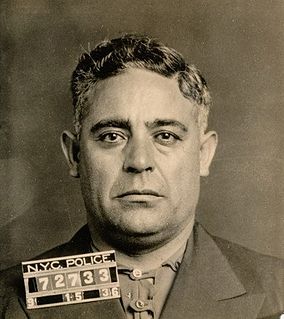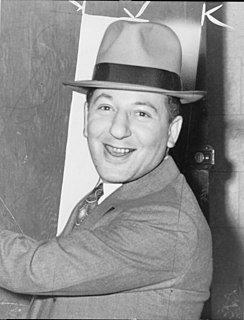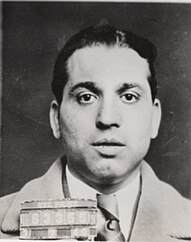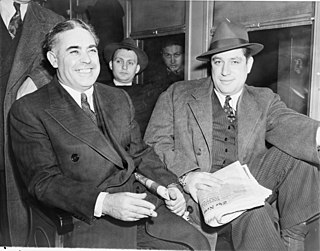Related Research Articles
Murder, Inc. was an organized crime group, active from 1929 to 1941, that acted as the enforcement arm of the Italian-American Mafia, the Jewish Mob, and other closely connected organized crime groups in New York City and elsewhere. The group was composed of Jewish-American and Italian-American gangsters, and members were mainly recruited from poor and working-class Jewish and Italian neighborhoods in Manhattan and from the Brooklyn neighborhoods of Brownsville, East New York, and Ocean Hill. It was initially headed by Louis "Lepke" Buchalter and later by Albert "The Mad Hatter" Anastasia. Murder, Inc. was believed to be responsible for between 400 and 1,000 contract killings, until the group was exposed in 1941 by former group member Abe "Kid Twist" Reles. Murder, Inc. committed hundreds of murders on behalf of the National Crime Syndicate during 1929 through 1941. In the trials that followed, many members were convicted and executed, and Abe Reles himself died after suspiciously falling from a window. Thomas E. Dewey first came to prominence as a prosecutor of Murder, Inc. and other organized crime cases.

Louis Capone was a New York organized crime figure who became a supervisor for Murder, Inc. Louis Capone was not related to Al Capone, the boss of the Chicago Outfit. Capone was convicted of murder in 1941, and sentenced to death. He was electrocuted at Sing Sing Prison on March 4, 1944.

Louis Buchalter, known as Louis Lepke or Lepke Buchalter, was an American mobster and head of the Mafia hit squad Murder, Inc., during the 1930s. Buchalter was one of the premier labor racketeers in New York City during that era.

Joseph Anthony Doto, known as Joe Adonis, was an Italian-American mobster who was an important participant in the formation of the modern Cosa Nostra crime families.

Harry "Happy" Maione was a New York mobster who served as a hitman for Murder, Inc. during the 1930s. Maione was called "Happy" because his face displayed an eternal scowl.
"Kid Dropper" Nathan Caplin or Kaplan, also known as Jack the Dropper, was an American gangster who controlled labor racketeering and extortion in New York City during the post-World War I period into the early years of Prohibition in the early 1920s.

Jack "Legs" Diamond, also known as Gentleman Jack, was an Irish American gangster in Philadelphia and New York City during the Prohibition era. A bootlegger and close associate of gambler Arnold Rothstein, Diamond survived a number of attempts on his life between 1916 and 1931, causing him to be known as the "clay pigeon of the underworld". In 1930, Diamond's nemesis Dutch Schultz remarked to his own gang, "Ain't there nobody that can shoot this guy so he don't bounce back?"

Emanuel "Mendy" Weiss was an American organized crime figure. He was an associate of the notorious Louis Buchalter and part of Buchalter's criminal organization known as Murder, Inc. during the 1930s and up to the time of his arrest for murder in 1941, for which he was convicted and, in 1944, executed. The Federal Bureau of Narcotics claimed that Weiss and his partner in crime Philip "Little Farvel" Cohen were heavily involved in narcotics trafficking. Although he was indicted on multiple drug charges, Weiss was never sentenced for any of these crimes.
Harry "Big Greenie" Greenberg was an associate and childhood friend of Benjamin "Bugsy" Siegel, and an employee of both Charlie "Lucky" Luciano and Meyer Lansky.

Waxey Gordon was an American gangster who specialized in bootlegging and illegal gambling. An associate of Arnold Rothstein during prohibition, he was caught up in a power struggle following Rothstein's death. Fellow Rothstein associates Charles Luciano and Meyer Lansky provided authorities with evidence that led to his imprisonment for ten years.
Joseph Amberg was a New York mobster who, with his brothers Hyman and Louis "Pretty" Amberg, was involved in labor racketeering and other criminal activities. During the 1920s and 1930s the brothers competed with rivals such as Jacob "Gurrah" Shapiro, Louis "Lepke" Buchalter, Abe "Kid Twist" Reles and the Shapiro Brothers. On September 30, 1935, Amberg was murdered alongside associate Morris Kessler. The pair were ambushed in a Brownsville, Brooklyn auto repair garage and, after being ordered to line up against the wall, were gunned down by members of Murder, Inc.
Hyman "Curly" Holtz, also known as "Little Hymie", was a New York labor racketeer who began working as a labor slugger for Jacob "Little Augie" Orgen during the early 1920s.
The Labor Sluggers War was a 15-year period of gang wars among New York City labor sluggers for control of labor racketeering from 1911 to 1927. This began in 1911 with the first war between "Dopey" Benny Fein and Joe "The Greaser" Rosenzweig against a coalition of smaller gangs and continuing on and off until the murder of Jacob "Little Augie" Orgen by Louis "Lepke" Buchalter and Gurrah Shapiro in 1927.
Abraham "Whitey" Friedman was a New York mobster and former associate of Nathan "Kid Dropper" Kaplan and later for labor racketeers Louis "Lepke" Buchalter and Jacob "Gurrah" Shapiro as an enforcer in New York's garment district during the 1920s and 1930s. One of many former associates killed by Murder, Inc. on the orders of Buchalter, he had recently been called in for questioning by investigators with crusading District Attorney Thomas E. Dewey and gunned down in a drive by as he was walking near his home on East 96th Street during the early evening of April 25, 1937,. Before his murder, Friedman was suspected of informing on Buchalter.

Louis Cohen was a New York mobster who murdered labor racketeer "Kid Dropper" Nathan Kaplan and was an associate of labor racketeer Louis "Lepke" Buchalter. He was killed along with Isadore Friedman, another Buchalter associate, who was believed to be an informant. It is not known whether Cohen was murdered for being a potential informant or whether he was accidentally killed during the shooting that was supposed to target Friedman.
Isadore or Irving Friedman, also known under the alias Danny Field, was a New York mobster and an associate of labor racketeer Louis "Lepke" Buchalter. He later agreed to testify against Buchalter on behalf of District Attorney Thomas E. Dewey as one of several high-profile witnesses scheduled to testify against Buchalter; however, he was murdered with Louis Cohen on January 28, 1939, shortly before his court appearance. Jacob "Kuppy" Midgen was believed to be the killer.
Benjamin "Benny the Boss" Tannenbaum was a New York mobster involved in narcotics and the fur rackets as well as a mob accountant for labor racketeer Louis "Lepke" Buchalter and Jacob "Gurrah" Shapiro. A friend of Bronx real estate agent Max Heitner, whom he had met at a New York summer resort, he was shot twice in the chest and killed while babysitting Heitner's four-month-old baby. Seymour "Blue Jaw" Magoon, a member of Murder, Inc., was later brought into custody for Tannenbaum's murder. It has been speculated, as he had knowledge of Charles "The Bug" Workman's role in the 1935 gangland slaying of Dutch Schultz, that Tannenbaum may have been targeted as a potential informant during District Attorney Thomas E. Dewey's prosecution against Louis Buchalter.
Morris L. Kessler was an American mobster and member of Joseph Amberg's gang in Brooklyn during the early 1930s. As Amberg's personal chauffeur and bodyguard, Kessler was a close associate in his organization until he was killed alongside his boss at a Brownsville auto garage by members of Murder, Inc. in 1935. The gangland slayings of Kessler and Amberg were among the first major contract killings committed by Murder, Inc. and was one of the most publicized of the era.
Philip "The Stick" Kovolick [Kovalick], also known as Joseph Farvel, was a New York mobster and a longtime associate of labor racketeer Louis Buchalter. He was one of the closest associates of Meyer Lansky, and assisted Meyer and his brother Jake Lansky in operating the Mob's Hallandale Florida casinos, including the plush "rug joint" the Colonial Inn.

Umberto "Albert" Anastasia was an Italian-American mobster, hitman, and crime boss. One of the founders of the modern American Mafia, and a co-founder and later boss of the Murder, Inc. organization, Anastasia eventually rose to the position of boss in what became the modern Gambino crime family. He also controlled New York City's waterfront for most of his criminal career, including the dockworker unions. Anastasia was murdered on October 25, 1957, on the orders of Vito Genovese and Carlo Gambino; Gambino subsequently became boss of the family.
References
- ↑ "5 Held in Wrecking of Clothing Plant; Men Are Accused as Gang Which Terrorizes Owners of Non-Union Factories" (PDF). The New York Times. July 18, 1929. p. 25.(subscription required)
- ↑ "Mulrooney Swears to Evil Repute of 3; Men on Trial Under New 'Public Enemy' Law Are Known as Racketeers, He Testifies" (PDF). The New York Times. December 20, 1931. p. 6.(subscription required)
- ↑ "9 'Public Enemies' are Freed by Court; State Failed to Show Group Met at Hotel With Unlawful Intent, Judge Holds" (PDF). The New York Times. December 25, 1931. p. 27. Retrieved November 10, 2011.(subscription required)
- ↑ "Hunted in Lepke Case: Narcotics Bureau Offers Reward for Capture of Kravitz" (PDF). The New York Times. December 23, 1939. p. 16. Retrieved November 10, 2011.(subscription required)
- ↑ "Reward Offered For Gangster". Palm Beach Daily News. December 23, 1939. p. 5. Archived from the original on July 12, 2012. Retrieved November 16, 2011.